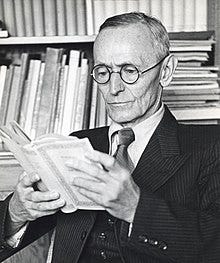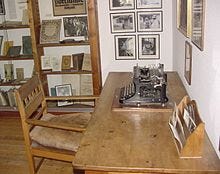Hermann Karl Hesse (July 2, 1877 - 1962) was the 1946 Nobel Laureate in Literature "for his inspired writings which, while growing in boldness and penetration, exemplify the classical humanitarian ideals and high qualities of style," wrote the Swedish Academy.
Born in the Black Forest town of Calw in Württemberg, Germany, Hermann Hesse was a German-French-Swiss-Estonian poet, novelist, and watercolor painter who loved music.
His best-known works are "Demian" (1919), the masterpiece "Siddhartha" (1922) set in India, and his last book "The Glass Bead Game" (1943), which took 11 years to write. Hesse was nominated for the Nobel Prize 8 times beginning in 1931.
But his most enduring success, "Der Steppenwolf" (1927), he stated, has been in large part misunderstood. After his death it would be hijacked by shills/ opportunists like Timothy Leary who wrongly imagined the mystical "magic theater" scenes were drug-induced, and thus skyrocketed Hesse to bestseller status in the U.S. where Hermann Hesse had previously been unknown despite having won a Nobel Prize.
In "Demian" and other books he wrote "for different people, there are different ways to God." The book had a huge impact on returning WWI veterans.
Similarly, "The Glass Bead Game," which includes the intellectual world of Castalia, seemed to encapsulize Germans' longing after the devastating losses of World War II.
Childhood & Youth
By age 13, Hesse knew he wanted to be a writer. An intelligent and strong-willed child, he became extremely well-read under the guidance of his polyglot grandfather, who gave him access to his library filled with books from throughout the world.
His grandparents had been Protestant missionaries in Southern India where his grandfather helped translate the Bible into Malayalam, and wrote a Malayalam-English dictionary and grammar book.
About his family's Christianity he stated, "their Christianity, one not preached but lived, was the strongest of the powers that shaped and moulded me."
Shortly after he started the 1st grade in school, Hesse began to experience deep depression. But things got much worse after he entered seminary as a teen. Although he did very well at first, he got into conflict, ran away from school, had similar experiences at other schools, got into terrible conflicts with his parents, attempted suicide, and was briefly put into a mental institution before finally graduating.
He writes about this in "Beneath the Wheel," and tells other stories of his childhood in "Gerbersau." (Here I recall that when Thomas Edison's 1st grade teacher complained about his behavior, his mother immediately withdrew Edison from school and home-schooled the genius herself, realizing the boy had nothing to learn from the small-minded teacher.)
Rather than subject himself to the university, Hesse decided to study on his own, reading all he could about spirituality in particular. He also studied Greek mythology, philosophy, and Jungian analysis, all of which made their way in his novels. However, being auto-didactic hampered his social relations with his peers.
Breakthrough
Hesse returned to Basel, Switzerland in 1899, where he'd lived as a child. In 1900, he was exempted from military service due to an eye condition. He also suffered nervousness and headaches throughout his life.
His first real breakthrough came with the publication of "Peter Camenzind" (1904) when Sigmund Freud praised it as among his favorite reading. It was eagerly read by young Germans seeking a more "natural" way of life.
Hesse soon married Maria Bernoulli (from a family of great mathematicians) without her father's approval.
Around 1910, Hesse discovered Theosophy and renewed a fascination with India. In 1911, he traveled to Sri Lanka, Indonesia, Borneo and Burma, but "the physical experience… was to depress him." The religious inspiration he sought eluded him, but positively impacted his writing nonetheless.
The Demons of War
In 1914, Hesse volunteered for the army, unable to sit the war out while others risked their lives. Even though unfit for combat, he guarded prisoners of war.
In his essay "O Friends, Not These Tones," he gently appealed to intellectuals not to fall into the nationalistic madness and hatred of war, reminding readers of Europe's common heritage: "Love is greater than hate, understanding greater than ire, peace nobler than war, this exactly is what this unholy World War should burn into our memories, more so than ever felt before".
But rather than calming the demons of war, his quiet words of wisdom set off murderous rage against himself. Hesse found himself under fire by the German press, the public, and old friends alike.
Only his friend Theodor Heuss and French writer Romain Rolland remained stood by him. Hesse wrote to Rolland, "The attempt…to apply love to matters political has failed."
Hostility still raged against him in 1916 when his father died, his son became seriously ill, his wife was sent to a mental institution (far more common within marriage than is acknowledged), and he was forced out of the military to get psychotherapy.
Out of the ashes, Hesse began a correspondence with Karl Jung and wrote "Demian" in 3 weeks in the fall of 1917, published under a pen name.
Between the Wars
In 1919, his wife recovered, but he declined to take her back. Their children were divided among relatives or sent to live in a boarding house, and Hesse moved to Ticino, Switzerland where he could finally focus on his writing and his painting, calling it "the fullest, most prolific, most industrious and most passionate time of my life."
In 1923, Hesse got Swiss citizenship and married Ruth Wenger, a singer and daughter of Swiss writer Lisa Wenger, but the marriage was unstable and short-lived. So he next moved in with his girlfriend, art historian Ninon Dolbin, a daring move that appears in his novel "Narcissus and Goldmund" (1930).
In 1931, Hesse and Ninon, who was Jewish, moved into a larger house built for him by his friend and patron Hans C. Bodmer. They were soon married.
The Third Reich
Hesse has been criticized, not for ditching his first two families, but for largely ignoring the Nazis from his home in Switzerland. He did, however, resist the Nazis by reviewing and publicizing the work of banned Jewish authors, like Franz Kafka, and opposing anti-Semitism.
In turn, Hesse's work was no longer published in Germany, and was soon banned.
Post-War Writing
For the final period of his life, Hesse switched to writing nature poetry and short stories about his childhood, as well as ironic essays. He also continued painting watercolors.
Fame brought lots of fan mail as well as interesting letter exchanges. He wrote a whopping 150 pages of correspondence per day during this period.
By the early 1970s, Hesse became the most widely read European author of the 20th century. Many of his books have been adapted into films, including most recently “Narcissus and Goldmund” (2020).
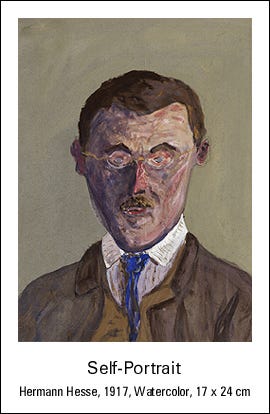
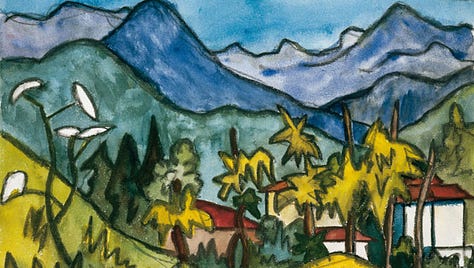
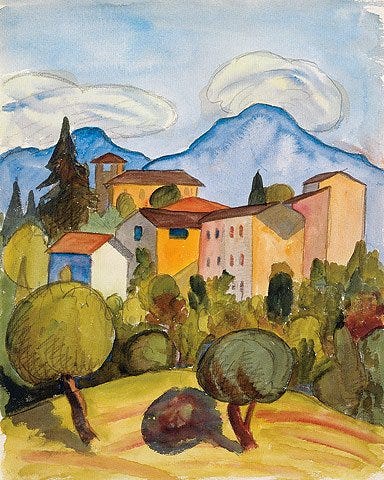
One never reaches home, but wherever friendly paths intersect the whole world looks like home for a time. —Hermann Hesse
Introducing Hernan Diaz, Winner of the 2023 Pulitzer Prize for Fiction
Every book begins out of chaos and persistent thoughts, says author Hernan Diaz. Born in Argentina and raised in Sweden, he finds it extremely odd that money affects every aspect of our lives and all of our relationships, and yet we don't talk about it. For many, it’s easier to walk down the street naked than to disclose their finances.




